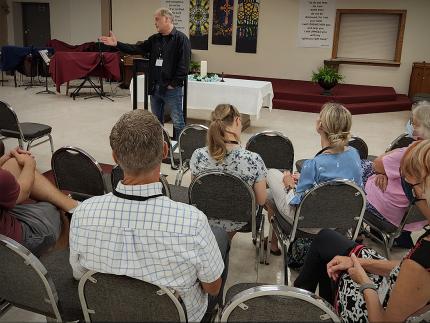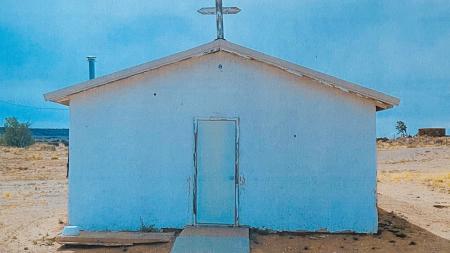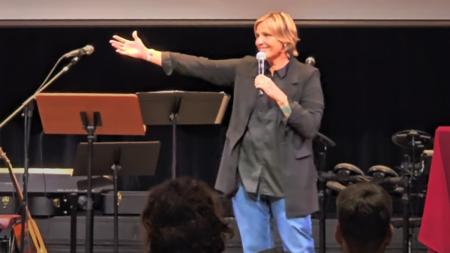Reflecting on ‘The Gift of the City’

After our “Workshop on Wheels,” in which we visited four inner-city ministries in Chicago during Inspire 2022, we gathered before dinner to reflect on the day’s experiences.
We had spent the day driving through various neighborhoods and stopping at Roseland Christian Ministries, Pullman Christian Reformed Church, Christ’s Vineyard CRC, and Lawndale Lighthouse CRC.
Joel Van Dyke, urban ministry leader for Resonate Global Mission, and Jodi Koeman, church with community leader for World Renew, organized and facilitated the workshop. And throughout the day we met church leaders and congregation members and saw firsthand many examples of the often-hard work as well as the gift of doing ministry in the inner city (see “The Gift of the City”).
Van Dyke had noted that during the COVID-19 pandemic, he, out of a long-held passion for learning about city ministry, had interviewed some 125 urban CRC ministry leaders to detail the rich, in-depth legacy of urban ministry in the CRCNA. That research led to a concept paper titled "The Gift of the City" and seeded the idea of spending a day on a “Workshop on Wheels” in Chicago during Inspire 2022.
In an urban ministry training guide titled An Incarnational Framework: An Introduction, Van Dyke also helps to define the approach that he and a global network of urban ministry practitioners (known as the Urban Training Collaborative) support in approaching how best to grasp “the gift of the city.”
“We want to see our cities and her most vulnerable residents through the eyes of Jesus. This is our ‘distinctive accent and flavor,’” explains Van Dyke.
I think we tried to do that during the workshop – keeping a focus on Jesus and the love, compassion, and willingness to face hard realities and embrace stories of extravagant grace.
As we sat around a table at the Tinley Park (Ill.) Convention Center to reflect on our day together, Mark Van Andel, a church planter and pastor in Detroit, began by summing up what he saw and by highlighting what he believes is an effective way to do ministry in the often harsh environment of the city.
“Faithfulness in urban ministry requires being present to the community around you, having solidarity with people in their suffering, trusting relationships and longevity, and being mindful of systemic and economic justice,” he said.
Carol Schaap, a member of New Hope Church in Lansing, Ill., grew up in South Holland, Ill., during the 1960s and was aware of the racial tension and white flight of churches from the city.
“Now I am a member of a church striving for racial justice and reconciliation,” she said. “This tour gave me new insight and understanding of the issues.”
Peggy Durrant, another participant, said she was especially impressed by Roseland’s ministry that shelters women and children “in a safe place to live until their situation is improved without concerns of being evicted. There were no prerequisites to attend church; they could freely decide to attend or not.” Another highlight was Roseland’s community store, where folks in the community could purchase things at a reasonable cost.
The main lesson she took away, she said, is that “despite being rejected by society and economically disadvantaged,” people have held no grudges toward their oppressors. “I also observed communities that are loving and caring and that have a desire to improve and thrive,” she said.
Jon Huizenga, a pastor and church planter in Cedar Springs, Mich., said he was thankful for the gift of these ministries to the Christian Reformed Church. “They inspired me with their community ministry and resilient faith.”
Troubling to him, he added, was that some of the urban neighborhoods are facing gentrification – an issue he faces in his work in Cedar Springs.
Larry Slings, a retired CRC minister, said he and his wife, Sandy, were deeply impressed by the commitment of the leaders and members of these churches and ministries.
“Both the length of their service and the personal costs that they have been willing to pay – all while seeing it as a privilege to be able to serve in these ways. It was inspiring for us and humbling!”
Tim Sheridan, director of church planting for Resonate, said one of his takeaways was to see how “a long, faithful presence in an urban neighborhood is both a pain-filled and joy-abounding opportunity to join God on mission and witness the kingdom of God breaking in.”
“I am humbled by the women and men who have been committed long-term to their urban neighborhoods,” he said.
James Jones, a co-pastor of Oakdale Park CRC in Grand Rapids, Mich., said he was also impressed and was reminded of the need for a ministry to stay in the city and to be open and creative in responding to the needs of the community.
It was impressive, he said, “to see how God is working in the city, where some would say, ‘No way can you make a difference in these places.’”
“But with God,” he said, “all things are possible. We saw how women, men, boys, and girls were doing ministry and changing lives in their communities. How old systems were being torn down and new ones put in place.”
As for me, I saw again how significant it can be for a church to remain where it is, for believers to keep doing ministry in many ways in the place where God has placed them. Somehow, it seems that these places of urban ministry are templates of how the Lord’s church ought to do its work.
Another strong image I take away is that of Debbie Flores on her knees in the entry to the Christ’s Vineyard ministry center, holding a bleeding and dying gang member in her arms.
We had heard about this scene at Christ’s Vineyard, where Debbie and her husband, Juan, have served for over 40 years, making clear to area gangs that they can ring their doorbell anytime if they need help. And on that night a dying young man rang that bell, and Debbie took him in.
Reflecting on the ongoing mission of the church to offer love and healing even in the face of death, that image of Debbie with the young man in her arms reminds me of the Pietà by Renaissance sculptor Michelangelo, which shows Mary, the mother of Christ, holding her dead son – killed on a cross – in her arms.
It is an image that prompts you to pay attention, to open your eyes so that you can see the gift that Jesus was to his mother and to the rest of us as well.
The city is a gift where the Spirit of God is alive and well, dancing in and through faithful women and men who are committed to love their urban neighborhoods into greatness. In the end, we ask, “How can the CRC continue to learn how to open the gift of the city?”


